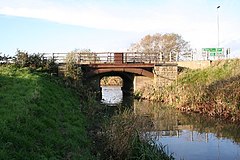Drinsey Nook
| Drinsey Nook | |
|---|---|
 Tom Otter's Bridge | |
 The Foss Dyke, frosted over | |
Location within Lincolnshire | |
| OS grid reference | SK870743 |
| • London | 153 mi (246 km) S |
| District | |
| Shire county | |
| Region | |
| Country | England |
| Sovereign state | United Kingdom |
| Post town | Lincoln |
| Postcode district | LN1 |
| Police | Lincolnshire |
| Fire | Lincolnshire |
| Ambulance | East Midlands |
| UK Parliament | |
Drinsey Nook is a small village in the West Lindsey district of Lincolnshire, England. It is situated approximately 2 miles (3 km) south-west from Saxilby, close to the county border with Nottinghamshire. The village sits on the bank of the Foss Dyke, a canal which runs from the River Trent at Torksey to the River Witham in Lincoln. The population of the village is included in the civil parish of Kettlethorpe.
The main building is the former Drinsey Nook Inn which is actually situated in Nottinghamshire; this was previously known as the 'Buffalo Inn' on old Ordnance Survey maps.
Drinsey Nook is notable for Tom Otter, a man who murdered his new wife in 1805. Otter, reputedly from Treswell, was already a married when he married his wife, Mary, whom he murdered the same day near the bridge that now bears his name. He was hanged in 1806, and was held in a Gibbet post adjacent to Gibbet Wood.[1][2] Tom Otter lane is the B1190 running south from the village, and Tom Otters Bridge is named after the site of the murder.[2][3]
More recently it has been the location of a case of modern slavery.[4][5]
References
- ^ The handbook guide to lincoln and business intelligencer (3 ed.). R. E. Leary. 1855. p. 64.
- ^ a b "Tom Otter - Fact or Fiction?". Saxilby and District History Group. 2013. Archived from the original on 5 October 2013. Retrieved 9 April 2013.
- ^ Pickering, W (1848). The Gentleman's Magazine (Vol 30 ed.). p. 296.
- ^ Halliday, Josh; Adam, Humairah (12 September 2017). "11 family members in Lincolnshire jailed in 'chilling' slavery case". Guardian Newspapers. Retrieved 6 August 2024.
- ^ "Rooney family slavery gang ordered to pay victims £1m". BBC News. Retrieved 7 August 2024.
External links
 Media related to Drinsey Nook at Wikimedia Commons
Media related to Drinsey Nook at Wikimedia Commons- The Tale Of Tom Otter

